Resource Utilization: What Is It and How to Calculate It?
Resource utilization is essential for getting the most out of your resources and driving agency profitability.
However, understanding the utilization rate formula is one thing. Getting the most out of this key capacity metric, knowing how to analyze it, and leveraging it for informed decision-making is another.
Which employee is available to schedule, and how does this impact your budget? Can you take on one more project? And which teams are overburdened? Utilization can tell you all of this and more.
This article will help you make these important decisions by exploring:
- The definition of resource utilization and its importance
- The difference between utilization, allocation, and billability
- How to calculate the resource utilization formula
- Ideal utilization and tips for improving it
Free Capacity Planning Template
Download our template to schedule time for billable vs non-billable tasks, track workloads, and get insights into utilization with preset formulas.

What Is Resource Utilization?
Resource utilization is a metric that shows how you use your business resources—whether they’re overburdened or not used enough. In an agency environment, this refers to people and their time, specifically the amount spent on billable projects vs. non-billable work.
This can tell you much about your individual teams, projects, and overall business operations management.
Utilization in IT and Other Industries
In IT resource capacity planning, utilization refers to your technological resources, such as servers. Proper utilization ensures your website or any other online service performs without interruptions.
It’s used in production and manufacturing, where it examines the capacity of machines, availability of materials, and the smoothness of the production line process (learn more on finite capacity scheduling).
This article will examine utilization in agency operations management, so if you’re interested in other industries, head over to one of the articles above.
Why Is Resource Utilization Important?
No matter which industry your business is in, without effective resource utilization management, you’ll be missing significant insights into your processes. Utilization is the primary metric for visualizing your efficiency and productivity.
However, it also influences other factors, such as business financial management, since your ratio of billable hours delivered directly impacts profitability.
Resource utilization also helps you improve your strategic HRP. By managing utilization, you can ensure that no one is overburdened or underburdened, which impacts employee satisfaction (and, ultimately, retention).
Difference in Resource Utilization vs Resource Allocation
Resource utilization and resource allocation are two very different terms.
Resource utilization is a metric that depicts the number of billable hours worked vs. total hours worked, depicted in percentages. On the other hand, resource allocation is the process of scheduling employees on projects according to availability.
Both of these terms are part of the broader capacity planning process. Your resource utilization will help inform allocation and vice versa.
Resource Utilization vs Billability
Another closely related term is billability. The difference in utilization in project management and billability can depend on your context and interpretation: for some, they are seen as synonymous terms. But you also see it as planned utilization (billability) vs what is actually done (utilization).
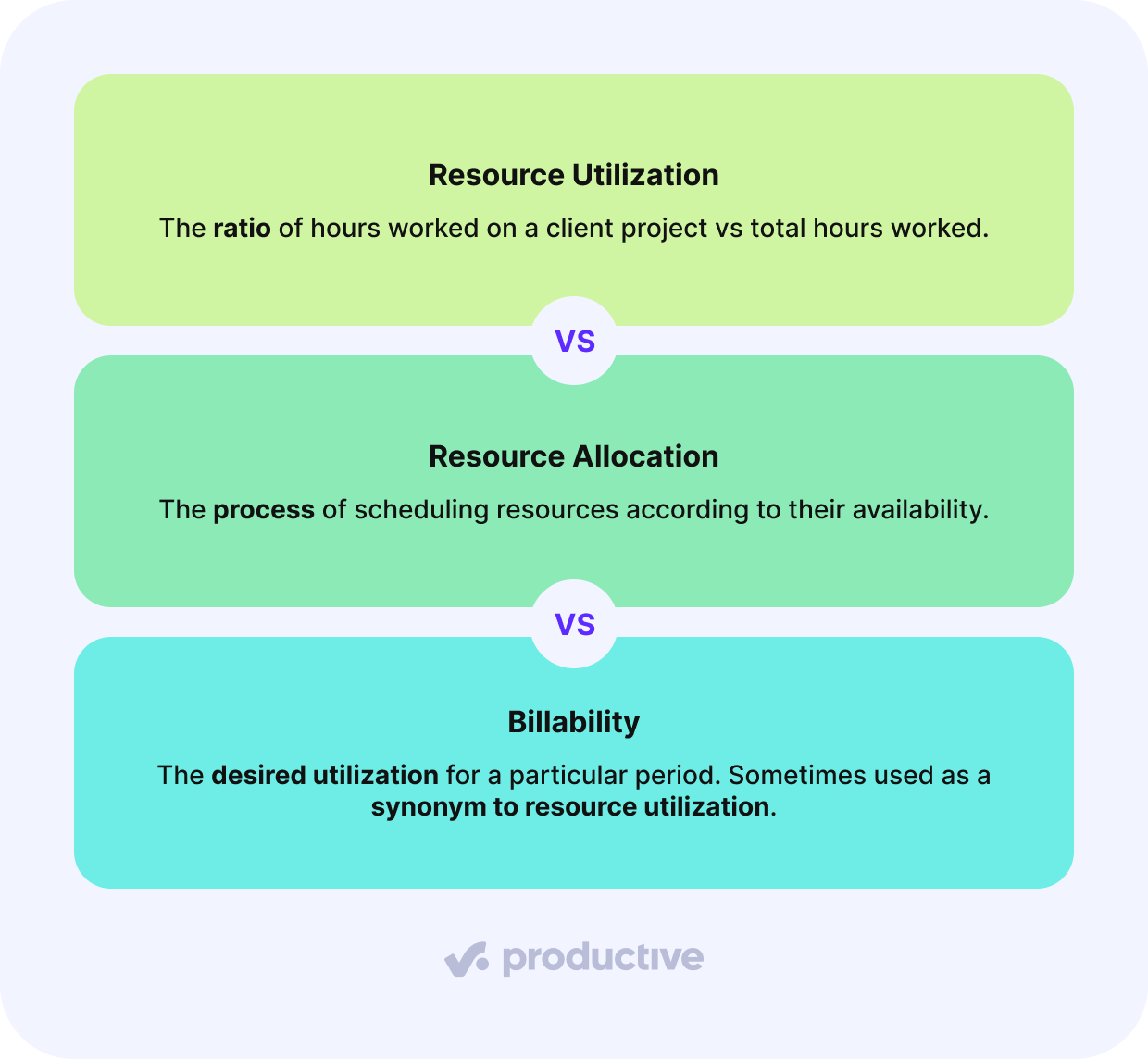
The Resource Utilization Formula
The typical resource utilization formula looks like this:
Resource utilization = amount of billable hours worked / total hours worked (x100)
For example, if a designer tracked 20 billable hours out of 40 total hours worked, that comes down to 50% of total utilization. Simple as that.
When predicting your future utilization, this formula looks a little different, though it boils down to the same thing:
Forecasted resource utilization = amount of scheduled hours / total availability (x100)
For this, you’re considering your employee’s potential or availability (including holidays and time off) and how they’re currently scheduled to gauge their utilization over time.
To get these insights, you’ll first need to implement a reliable way to manage time tracked. Time tracking usually isn’t an employee’s favorite activity, so it’s best to simplify it as much as possible.
For example, you can use time keeping software with features like:
- tracking time directly from tasks with a timer
- pinning frequently tracked projects and services
- or even full time entry automation
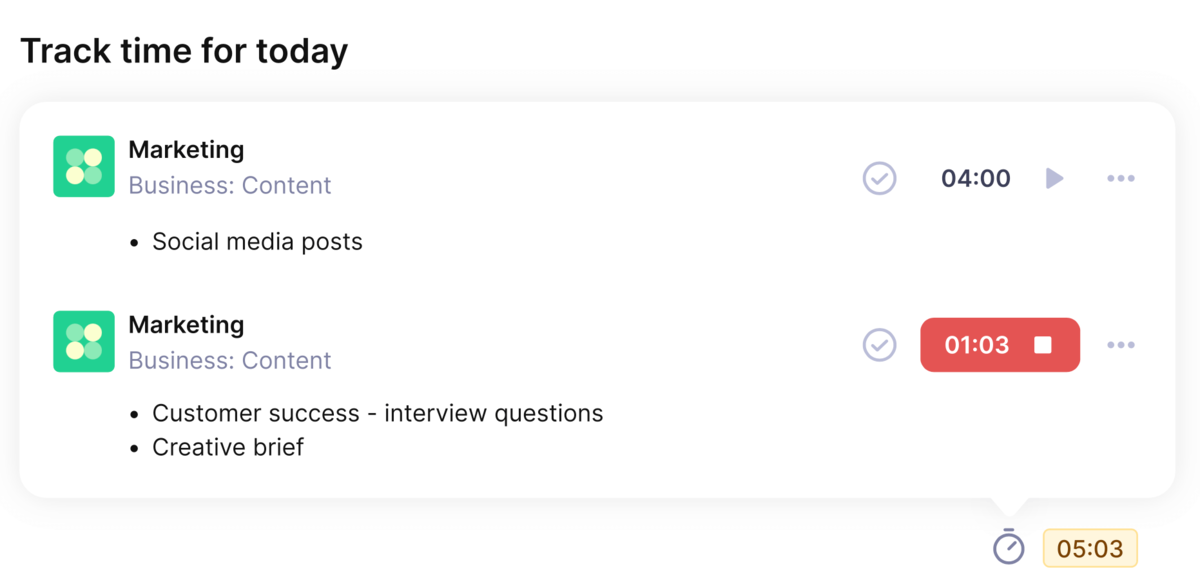
Productive’s Time Tracking can do all of this and more
You can manage these numbers in spreadsheets, but this will invite potential errors and make the process a chore for project managers. Not to mention making sure that time off and holidays are accounted for.
Calculate Your Resource Utilization
Switch from spreadsheets to an all-in-one tool that helps you manage your billable hours and get real-time utilization insights.
Analyzing Real-Time Utilization
Resource utilization can be tracked across individual employees, but you can also do it across various categories — per department, per seniority, per project, and even on an agency basis.
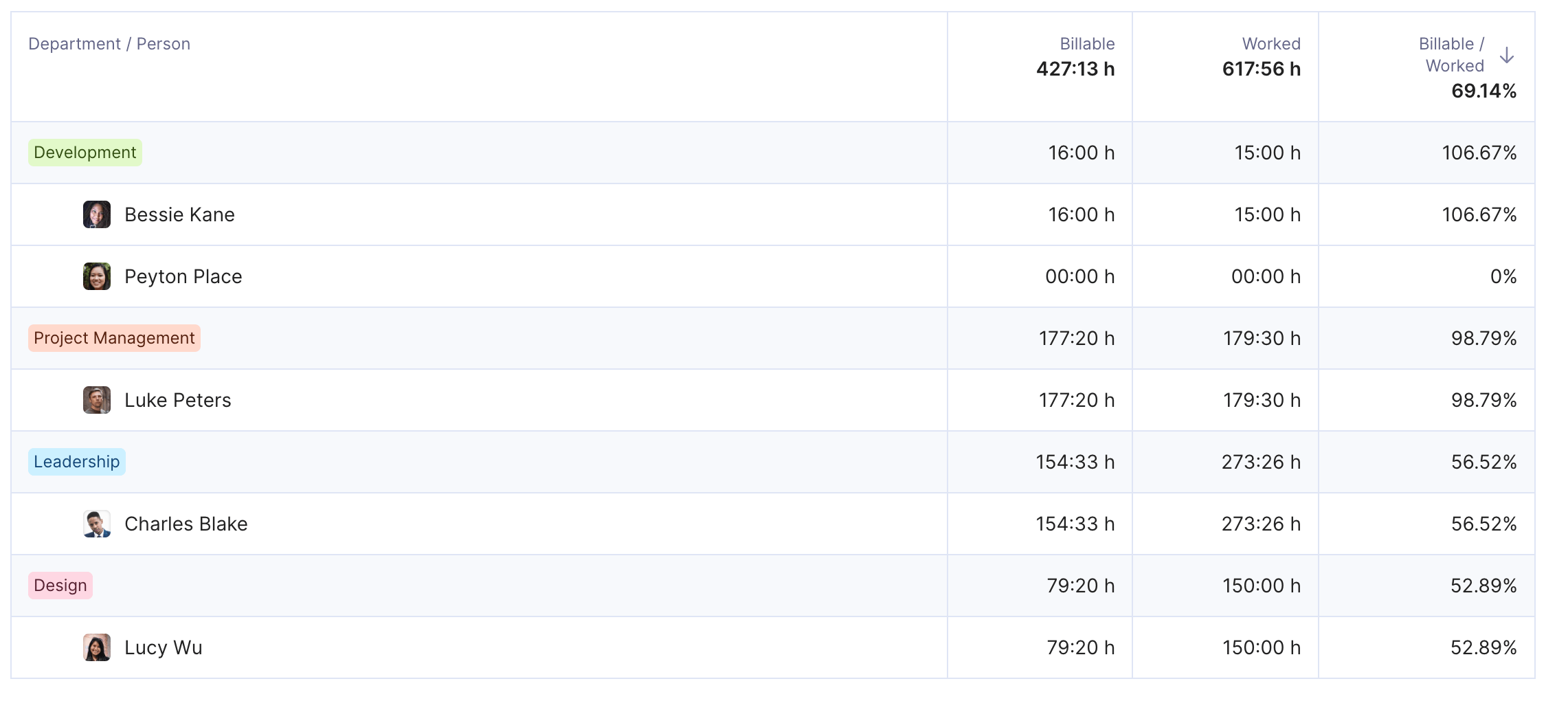
Productive’s utilization report helps you visualize and forecast your team utilization
All of this can give you different valuable insights. Here are three examples:
1. Guiding Hiring
For example, if you’re measuring utilization per department, for example design vs development, you can gauge which of your services are consistently overutilized or underutilized. You can then consider hiring for popular services, or pitching for projects in underutilized areas.
2. Optimizing Project Performance
If employees are billing less hours than expected or usual on certain projects, this can signal issues in your workflows. Are non-billable hours being tracked due to miscommunication or constant scope increases? You can use this information to make your project workflows more efficient or renegotiate potentially unprofitable engagements.
Check out our guide on client profitability analysis to learn more.
3. Making Strategic Decisions
You can also visualize and forecast your agency-wide resource utilization to make better decisions on a business level. For example, based on already allocated insights, you can predict how busy you’ll be in the upcoming months. You can then decide whether you have enough capacity to take on new projects.
That’s a key thing that we get out of the reports that really feeds into our utilization and resourcing. If we know we’re spending 30% of our time on internal projects, then we know we’ve got the capacity to take on more work.
Learn how you can use Productive to get key insights for transforming your operations.
The Benefits of Resource Utilization
The benefits of calculating utilization of resources include:
- More scheduling visibility and flexibility, which results in reduced scope creep and budget overrun risk
- Better project prioritization and strategic decision-making according to reliable data
- Decreased risk of employee burnout, which directly impacts retention and turnover
- Easier to identify repetitive processes and non-billable tasks that can be automated
- All of this results in improved client relationships, profit margins, and more satisfied team members
5 Techniques and Tips for Improving Utilization
How can you get optimal resource utilization? Here are some essential things to consider:
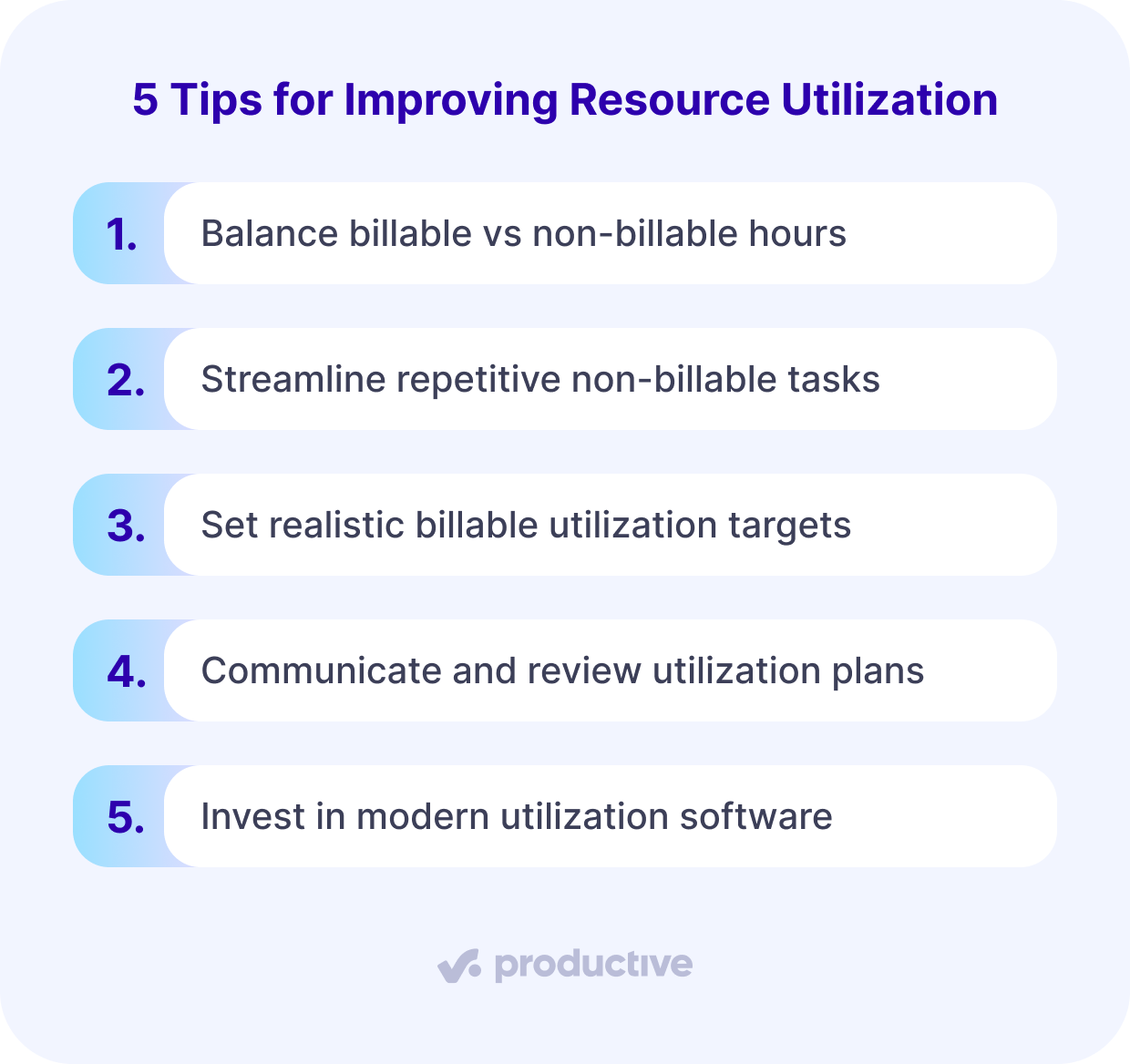
Let’s explore them in more detail.
1. Balance Billable and Non-Billable Hours
First, keep in mind that you don’t want your billable resource utilization percentage to be too high. Industry benchmarks reporting the following as average utilization across roles:
- 33% for director roles
- 63% for senior roles
- 74% for mid-level roles
- 75% for junior roles
- 65% average for the whole business
Source: The Wow Company
The recommended rate is somewhere between 70 to 90% for production-level staff. This ensures that you’re not neglecting essential non-billable activities, such as administrative tasks, training, internal meetings, etc. Although they don’t generate income directly, all of these activities have a significant role in ensuring sustainable day-to-day operations.
Additionally, keep in mind that utilization can ebb and flow depending on demand and other external factors. Even if certain months have lower utilization than expected, this isn’t always a call for concern.
2. Streamline Repetitive Tasks
However, this doesn’t mean that you can’t streamline some non-billable tasks, especially those that require less care and oversight. For example, common non-billable activities that can be automated in some capacity include:
- time tracking
- invoicing
- task management
- data collection
Implementing a software solution to manage some parts of these activities can not only free up valuable employee time, but also at times produce more reliable results.
For example, automated invoicing and data collection can ensure that information is more accurate. With task management, even something minor like a task being updated and a notification or message being sent immediately can reduce the chance of updates slipping through the cracks.
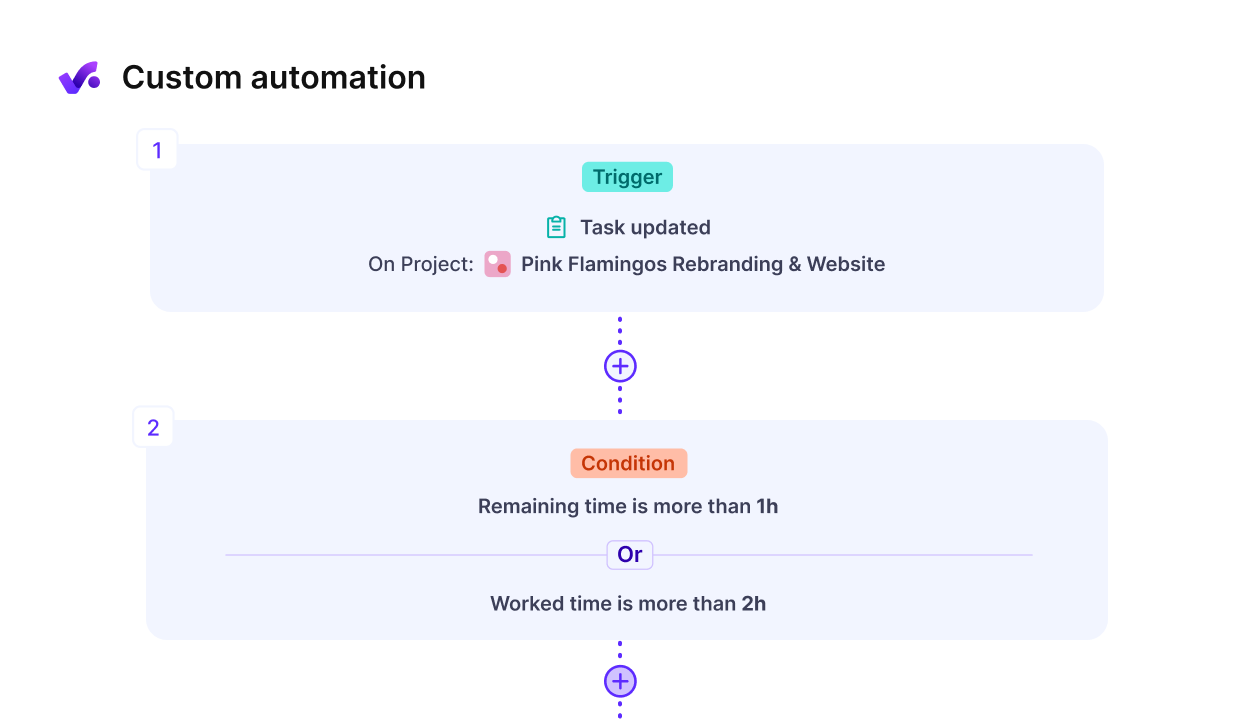
Productive offers no-code automations for setting up efficient workflows
Automation can also make your employees happier, as more than 60% of workers believe that it helps fight burnout and work-related stress (Zapier). In short, by using automation features, agencies can improve efficiency and accuracy, increase employee satisfaction, and dedicate more time to revenue-generating activities.
3. Make Realistic Estimates
Another important thing to consider is: are your estimates realistic?
If you’re expecting too much from employees, it’s unlikely that you’ll be hitting your target resource utilization rates.
For this, conducting a thorough analysis of planned vs actual time spent on tasks is important. Not only does it help you make better estimates for future projects, but it can also help resource managers:
- Understand when and why projects go off track
- Prepare for potential risks and challenges ahead of time
- Establish more transparent client communications
- Ensure better adherence to budgets and timelines
Make sure you have an efficient time tracking system established to track billable time across project resources.
4. Communicate and Review Your Utilization Plan
Once you’re sure you’ve set up realistic targets, make sure you communicate these goals and performance metrics to your teams. Everyone should know what’s being expected of them to avoid underperformance due to miscommunication.
Then, make sure you’re checking in and reviewing these goals regularly. Are there any new internal or external circumstances that might affect your billable utilization rates targets, such as extended periods of resource unavailability or fluctuations in client demand?
Consider this to ensure your plan is up to date.
5. Find a Utilization Tool for Analysis and Forecasting
According to Capterra, using advanced resource management software can bring many benefits to your business, such as more effective use of project resources (55%), better budget estimation (48%), and more accurate metrics (38%).
Some features to keep a look out for in utilization software include:
- integrated billable hours management
- resource availability management (integrated integrated time off and holiday calendars)
- a responsive resource allocation template for scheduling and rescheduling
- financial forecasting based on resource scheduling (budget burn and profit)
When you’re browsing resource management tools, make sure that they’re offering financial management features alongside resourcing and project management. This ensures that your tool can support your growth.
When it came to gathering financial utilization data, we took a lot of rough estimates from Asana and Google Sheets, which led to many inaccuracies and distrust of the data. If even one metric was off, it could throw off the entire calculation, essentially making the data completely useless. We really needed an all-in-one tool.
Productive – The Best Software for Resources and Utilization Reports
Productive is an all-in-one solution for agency project resource management. What makes it ideal for professional services businesses?
For one, it’s designed specifically for agency workflows, so you can be sure you’re getting a tool that understands your pain points and challenges.
The other important aspect is that it’s not simply a solution for managing projects. Productive is a utilization tool with in-depth reporting and financial features designed to drive knowledge on resource planning and business activities.
Our business decisions are never made on an inner feeling or intuition. Productive gives you answers to questions like what’s the profit, how much are the expenses, what’s the projected revenue, what’s the utilization? That entire set of key metrics is what gives management a basis to move forward.
Key features include:
- Billable hours tracking and time off management
- Resource utilization plan with capacity indicators
- Profitability, revenue, utilization reports, and forecasting
- Budgeting and invoicing
- Project and task management
- Automations, custom permissions, sales CRM, and more
Book a demo with Productive today to find out more.
You can also go to our article on billable utilization to keep reading on this topic.
Connect With Agency Peers
Access agency-related Slack channels, exchange business insights, and join in on members-only live sessions.

